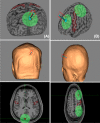Repetitive Transcranial Magnetic Stimulation as a Therapeutic and Probe in Schizophrenia: Examining the Role of Neuroimaging and Future Directions
- PMID: 33844154
- PMCID: PMC8423934
- DOI: 10.1007/s13311-021-01046-1
Repetitive Transcranial Magnetic Stimulation as a Therapeutic and Probe in Schizophrenia: Examining the Role of Neuroimaging and Future Directions
Abstract
Schizophrenia is a complex condition associated with perceptual disturbances, decreased motivation and affect, and disrupted cognition. Individuals living with schizophrenia may experience myriad poor outcomes, including impairment in independent living and function as well as decreased life expectancy. Though existing treatments may offer benefit, many individuals still experience treatment resistant and disabling symptoms. In light of the negative outcomes associated with schizophrenia and the limitations in currently available treatments, there is a significant need for novel therapeutic interventions. Repetitive transcranial magnetic stimulation (rTMS) is a non-invasive brain stimulation technique that can modulate the activity of discrete cortical regions, allowing direct manipulation of local brain activation and indirect manipulation of the target's associated neural networks. rTMS has been studied in schizophrenia for the treatment of auditory hallucinations, negative symptoms, and cognitive deficits, with mixed results. The field's inability to arrive at a consensus on the use rTMS in schizophrenia has stemmed from a variety of issues, perhaps most notably the significant heterogeneity amongst existing trials. In addition, it is likely that factors specific to schizophrenia, rather than the rTMS itself, have presented barriers to the interpretation of existing results. However, advances in approaches to rTMS as a biologic probe and therapeutic, many of which include the integration of neuroimaging with rTMS, offer hope that this technology may still play a role in improving the understanding and treatment of schizophrenia.
Keywords: MRI; Repetitive transcranial magnetic stimulation; Schizophrenia; fMRI.
© 2021. The American Society for Experimental NeuroTherapeutics, Inc.
Figures


Similar articles
-
Structural and functional brain biomarkers of clinical response to rTMS of medication-resistant auditory hallucinations in schizophrenia patients: study protocol for a randomized sham-controlled double-blind clinical trial.Trials. 2019 Apr 23;20(1):229. doi: 10.1186/s13063-019-3311-x. Trials. 2019. PMID: 31014369 Free PMC article.
-
Effects of low frequency rTMS treatment on brain networks for inner speech in patients with schizophrenia and auditory verbal hallucinations.Prog Neuropsychopharmacol Biol Psychiatry. 2017 Aug 1;78:105-113. doi: 10.1016/j.pnpbp.2017.04.017. Epub 2017 Apr 22. Prog Neuropsychopharmacol Biol Psychiatry. 2017. PMID: 28442422 Clinical Trial.
-
Neuroimaging and neuromodulation approaches to study eating behavior and prevent and treat eating disorders and obesity.Neuroimage Clin. 2015 Mar 24;8:1-31. doi: 10.1016/j.nicl.2015.03.016. eCollection 2015. Neuroimage Clin. 2015. PMID: 26110109 Free PMC article. Review.
-
Brain connectivity and auditory hallucinations: In search of novel noninvasive brain stimulation therapeutic approaches for schizophrenia.Rev Neurol (Paris). 2016 Nov;172(11):653-679. doi: 10.1016/j.neurol.2016.09.001. Epub 2016 Oct 11. Rev Neurol (Paris). 2016. PMID: 27742234 Review.
-
[Interactive rTMS protocols in psychiatry].Encephale. 2013 Dec;39(6):426-31. doi: 10.1016/j.encep.2013.04.009. Epub 2013 Jun 28. Encephale. 2013. PMID: 23810752 Review. French.
Cited by
-
Transcranial Magnetic Stimulation as a Therapeutic Option for Neurologic Diseases and Psychiatric Disorders: A Systematic Review.Cureus. 2022 Aug 22;14(8):e28259. doi: 10.7759/cureus.28259. eCollection 2022 Aug. Cureus. 2022. PMID: 36158376 Free PMC article. Review.
-
Multimodal neuroimaging unveils basal forebrain-limbic system circuit dysregulation in cognitive impairment with depression: a pathway to early diagnosis and intervention.J Prev Alzheimers Dis. 2025 Sep;12(8):100298. doi: 10.1016/j.tjpad.2025.100298. Epub 2025 Jul 16. J Prev Alzheimers Dis. 2025. PMID: 40675918 Free PMC article.
-
Early efficacy of rTMS intervention at week 2 predicts subsequent responses at week 24 in schizophrenia in a randomized controlled trial.Neurotherapeutics. 2024 Sep;21(5):e00392. doi: 10.1016/j.neurot.2024.e00392. Epub 2024 Jun 29. Neurotherapeutics. 2024. PMID: 38944636 Free PMC article. Clinical Trial.
-
Repetitive transcranial magnetic stimulation for psychiatric symptoms in long-term hospitalized veterans with schizophrenia: A randomized double-blind controlled trial.Front Psychiatry. 2022 Sep 23;13:873057. doi: 10.3389/fpsyt.2022.873057. eCollection 2022. Front Psychiatry. 2022. PMID: 36213928 Free PMC article.
-
Self-Regulatory Neuronal Mechanisms and Long-Term Challenges in Schizophrenia Treatment.Brain Sci. 2023 Apr 12;13(4):651. doi: 10.3390/brainsci13040651. Brain Sci. 2023. PMID: 37190616 Free PMC article. Review.
References
-
- Disease GBD, Injury I, Prevalence C. Global, regional, and national incidence, prevalence, and years lived with disability for 354 diseases and injuries for 195 countries and territories, 1990–2017: a systematic analysis for the Global Burden of Disease Study 2017. Lancet. 2018;392(10159):1789–1858. doi: 10.1016/S0140-6736(18)32279-7. - DOI - PMC - PubMed
-
- Breier A, Schreiber JL, Dyer J, et al. National Institute of Mental Health longitudinal study of chronic schizophrenia. Prognosis and predictors of outcome. Arch Gen Psychiatry. 1991;48(3):239–46. - PubMed
Publication types
MeSH terms
Grants and funding
LinkOut - more resources
Full Text Sources
Other Literature Sources
Medical

